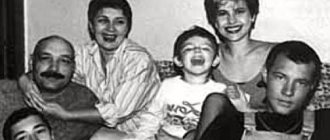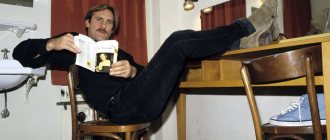Biography
The biography of Pavel Kadochnikov is a bright kaleidoscope of wonderful roles, amazing meetings, popular love and tragic events.
The future great artist was born in Petrograd in a difficult and alarming time. A civil war was raging in the country, so the father sent the family to their native village in the Perm province. There, Pavel and his younger brother Nikolai quickly mastered the simple peasant life: chopping wood, herding cows, and working in the fields. The mother tried to instill in her sons a love of art, teaching them to draw, sing, and play musical instruments. From an early age, Pavel stood out for his obvious artistic abilities; he loved to depict scenes from village life. While still studying at a rural school, the young man decided to connect his future life with creativity and become an artist.
Pavel Kadochnikov in his youth
In 1927, the family returned to Leningrad, and he entered an art studio. When his father suddenly fell ill, Pavel went to work at a factory to feed his family. It was difficult, but the young man did not give up painting and combined work with study in the studio. Once at a concert where Pavel famously performed ditties, the head of the theater school noticed him and invited him to an audition. The talented boy easily passed the exams and was enrolled in the first year. And soon the educational institution was given the status of an institute, and at the age of fifteen Kadochnikov became a student at a theater university, and at twenty he was already teaching stage speech there.
Pavel Kadochnikov in his youth
Despite his young age, Pavel did not get lost among his classmates. By that time, a simple village guy had turned into a tall, stately young man who knew how to dress tastefully and passionately perform Neapolitan folk songs that drove girls crazy.
Pavel Kadochnikov as Lelya in the fairy tale “The Snow Maiden”
After graduating from the institute, the aspiring actor was enrolled in the troupe of the Leningrad Youth Theater. His first work on stage was the role of Lel in the fairy tale “The Snow Maiden,” followed by a whole series of bright theatrical images that made people talk about Kadochnikov as a new talent, endowed with undoubted talent.
Pyotr Kadochnikov: biography
Pyotr Pavlovich Kadochnikov was born on December 27, 1944 in a small village near the Georgian capital Tbilisi. Then the family moved to live in their native Leningrad.
Little Pyotr Kadochnikov grew up as an obedient child, inquisitive and responsive. The guy showed good results in his studies and learned something new from every lesson. The future artist graduated from high school with honors, receiving a gold medal. This was followed by admission to the Leningrad Polytechnic Institute at the Faculty of Physics.
Having received a higher education, Pyotr Kadochnikov, like his parents in his youth, decided to connect his life with stage activities. To do this, he continued his studies at the Leningrad State Institute of Music, Theater and Cinematography. Here he proved himself to be a diligent student, receiving a diploma with honors.
Pyotr Kadochnikov (actor) refused to act in films for a long time. The reason for this is extreme shyness, which manifested itself in the guy from early childhood. His father Pavel recalled that he literally had to lead his son by the hand through the directors’ offices. Instead of regular filming, Pyotr Kadochnikov gave preference to writing scripts, the creation of which he could work all night long. Nevertheless, the young artist’s father always supported his son’s endeavors and was proud of his rather modest achievements.
Movies
One day, director Sergei Yutkevich came to watch the play “The Snow Maiden”. Pleasantly surprised by the performance of the aspiring actor, he invited him to his new film “Man with a Gun.” Before this, Pavel already had an unsuccessful filming experience, after which he became disillusioned with cinema, but still accepted the director’s offer. And I didn’t regret it. The tiny role of a young soldier opened the way for Kadochnikov to big cinema.
Two years later, in Yutkevich’s new film “Yakov Sverdlov”, he played two roles simultaneously - the simple village boy Lenka and the great Maxim Gorky. Yutkevich was the first to discover in the young actor this amazing ability to transform, which other eminent directors would then use in their works.
Pavel Kadochnikov as Maxim Gorky
During the war, Pavel actively starred in films on patriotic themes, designed to raise the spirit of the Soviet people in the fight against the invaders. He was not even sent to the front because of this.
In 1942, the actor starred in “Ivan the Terrible” by the great Eisenstein, where he played three roles at once. Two of them were episodic, but the image of Staritsky, brilliantly embodied by Kadochnikov, delighted the director himself. This was followed by the role of Major Fedotov in the film “The Exploit of a Scout,” which brought Kadochnikov his first Stalin Prize.
Pavel Kadochnikov in the film “The Exploit of a Scout”
The second time the country's highest award was given to the actor for his role as pilot Maresyev in "The Tale of a Real Man." To get into the character more realistically, Kadochnikov crawled through the snow in the bitter cold without stunt doubles and wore prosthetics throughout the filming. The legendary Maresyev himself was amazed by the courage of Pavel Petrovich, noticing that he looked more like a real hero than him.
Pavel Kadochnikov in the film “Tales of a Real Man”
The actor received the third Stalin Prize for his role in the film “Far from Moscow.” Soon the heroic characters played a cruel joke on the actor. He became a hostage to one image, which moved from film to film, becoming boring and uninteresting.
The picture “Tiger Tamer” changed the situation, which again brought Kadochnikov to the pinnacle of fame and success. His partner in the film was the charming Lyudmila Kasatkina, who at one time won many men’s hearts. It was rumored that sympathy arose between them on the set; Kadochnikov confessed his love to the actress and was even ready to leave his family for her sake. But Kasatkina flatly refused to leave her husband, and their romance ended there.
Pavel Kadochnikov and Lyudmila Kasatkina
After the triumphant release of the film, Pavel Petrovich became the favorite of all women in the country. Fans did not give him access and filled him with bags of love letters. But the actor also soon became bored with this role of a romantic hero, and he wanted to take up directing work.
Acting work
Pavel's love for drawing pushed him to study in a theater studio. He designed simple decorations there and at the same time participated in productions. One fine day, Kadochnikov, while working, sang several mischievous ditties that he had learned back in the village. The director immediately invited him to participate in the play. From that moment on, Pavel Petrovich’s creative career began. He entered the performing arts technical school and received a specialized education.
Kadochnikov played with great desire any roles that were assigned to him. The young actor's repertoire included animals, fairy-tale characters, White Guards and even pieces of furniture. Film directors began to notice the versatile actor. He received his first roles in the films “Man with a Gun” and “Yakov Sverdlov”. When the war began, Kadochnikov persistently asked to go to the front. However, he was refused and rightly so. Pavel Petrovich played one of his best roles in the film “The Feat of a Scout.”
Like many talented actors, Kadochnikov tried his hand at directing. He made a quite decent film, “Musicians of the Same Regiment,” which was warmly received by the audience. The critics remained silent. The personal life of Pavel Kadochnikov was successful. He was married to Rosalia Kotovich for more than fifty years. The husband and wife raised and raised a son, who also became an actor. Pavel Kadochnikov died in May 1988.
Directing
Leaving for directing was associated with another reason. Since the mid-sixties, Kadochnikov was no longer filmed. Only in 1976, after a long break, Nikita Mikhalkov called him to his “Unfinished Piece for Mechanical Piano.” All this time, the Stalinist laureate was forced to tour the cities and towns of his vast homeland with concerts, and in his free time he painted, wrote poetry and prose, and was engaged in sculpting and sculpture.
Pavel Kadochnikov in the film “Silver Strings”
It was then that the idea came to test myself as a director. In 1965, his first film “Musicians of the Same Regiment” was released, in which Kadochnikov the director played a small but memorable role of the musician Chulkovsky. Three years later, he staged the musical fairy tale “The Snow Maiden,” again returning to his favorite theme, which opened the way for him to the magical world of art.
In 1984, he directed the film “I Will Never Forget You,” and his last directorial work was the film “Silver Strings,” which was released a year before Kadochnikov’s death.
Kadochnikov. Legend of hand-to-hand combat
Kadochnikov Alexey Alekseevich. There are still many “blank spots” left in the biography of this man, and before Gorbachev’s “perestroika” only his closest people and a narrow circle of intelligence officers knew him by sight. But after a certain point, he became widely known not only in our country, but also abroad as the author of his own system of hand-to-hand combat.
General, academician and cavalier
Former military pilot and combat swimmer of the USSR Navy. Subsequently, he became an instructor in special forces of various security forces of the Soviet Union and Russia. He had many well-deserved ranks and titles: academician of the Russian Academy of Natural Sciences, academician of the Academy of Security, Defense and Law Enforcement, honorary professor of the Academy of the Federal Border Guard Service, Doctor of Science, Major General of the Orenburg Separate Cossack Army and holder of state awards. He has several inventions to his credit, most of which remain closed. He is the author of a number of books, brochures and several educational films. He even starred in the feature film “Painful Hold.”
Family and childhood
Alexey Alekseevich was born on July 20, 1935 in the south of Ukraine, in the seaside city of Odessa.
His parents met in Moscow. My father then served in the Red Army Air Force, and my mother worked in Metrostroy and studied at a technical school. Alexei’s grandfather himself was from the Ural Cossacks, he worked as a cabinetmaker, and he also built ships and repaired airplanes. During the First World War he became a Knight of St. George, earning three crosses. Most likely, Alexei’s grandfather was one of the Plastun Cossacks, who were unsurpassed intelligence officers in the war, a kind of Cossack special forces. The Plastuns had such extraordinary abilities that they could climb deep into enemy territory for a long time, camouflage themselves perfectly, sneak up covertly, they even knew how to “avert the eyes” of sentries and were excellent in the art of hand-to-hand combat. My father adopted martial art from his grandfather, and during the war this knowledge saved his life more than once. In 1939, the Kadochnikov family moved to Krasnodar. Father and mother were serving in Air Force units at that time. But soon the war began. His father went to the front, and seven-year-old Alexei and his mother were evacuated to the city of Pugachev, Saratov region. But the mother does not give up trying to return to military aviation, and they return to Krasnodar. She manages to feel needed for a while, but not for long. And when there were almost no cars left in the unit, and the enemy was on the outskirts of Krasnodar, she and little Alexei again left the city along with the crowds of refugees. He remembered how they crossed the Kuban under fire, how they were often bombed while they reached the foothills of the Caucasus, and then went through mountain passes to Georgia. One day he was heavily covered with thrown earth from a nearby bomb explosion, but he remained unharmed. Protecting him from falling, his mother tied little Alexei, exhausted from the long journey, to the horse saddle. When suddenly a German landing party unexpectedly appeared in front of the refugees, and machine gun fire roared, the frightened horse reared up and, literally scattering the Germans with its hooves, carried him out of the heat. Farther and farther from the battlefield she carried the boy hanging from the girth of the saddle under the horse’s belly. Later, on cold nights, he often had to fall asleep, clinging to the warm horse side of his savior.
In the military unit where he and his mother were placed to live, scouts were trained before being deployed behind enemy lines. Like any boy, he liked to watch hand-to-hand combat instructors at work. He already knew something from his grandfather and now carefully watched the movements of the fighters, memorized...
My father returned from the war as an invalid. It was not easy for the Kadochnikov family in the post-war years. My parents then worked in oil and gas exploration, and they often had to change their place of residence - from the Caucasian Mineralnye Vody to Rybinsk, near Yaroslavl. Alexey graduated from high school when the family lived in Stavropol. As an inquisitive teenager, he enthusiastically participated in the flying club and radio circle.
More than eighteen specialties
Having decided to follow in his father’s footsteps, Alexey Kadochnikov dreamed of becoming a military pilot. He entered the Kharkov Aviation Military School, and, having shown extraordinary diligence during his studies, received an offer to continue his military education at the Yeisk Special School. Most likely, it was the Naval Aviation School named after I.V. Stalin, where military seaplane pilots were trained. He received not only a pilot's diploma, but also took a special course as a combat swimmer and mastered eighteen more specialties, including radio engineering, mine clearance, driving, shooting, topography, navigation of rivers and seas. From 1955 to 1958, he served in the USSR Armed Forces, where the skills acquired during his studies were honed in a “closed and legendary” military structure. But Khrushchev’s army reduction began, affecting both aviation and special forces created on the initiative of Marshal Zhukov. So, at the very peak of his military career, Alexey Kadochnikov was sent to the reserve.
"School of survival"
Returning to Krasnodar, he practices hand-to-hand combat, boxing, studies specialized literature and continues to analyze the knowledge he has gained.
Between 1959 and 1983. Kadochnikov worked in various organizations and research institutes in Krasnodar, even was the dean of the Kuban State University of Physical Culture, Sports and Tourism, and conducted research in the system of the USSR Ministry of Defense. He himself said that since 1962 he had been training personnel for various law enforcement agencies and military schools in Krasnodar. In 1965, he graduated from the Krasnodar Polytechnic Institute in absentia, received a degree in engineering and began recruiting students for hand-to-hand combat classes. At that time, all types of martial arts for civilians were prohibited, and his classes were called the “School of Survival.” He studied with cadets of the Krasnodar Higher Military School named after Army General Shtemenko, passing on to them his knowledge acquired at the special school. He drove future military cryptographers “up to their breaking point” during training in the pool of the Dynamo stadium, forcing them to work both in and under water. Since 1983, Kadochnikov worked as the head of the laboratory at the Department of Mechanics of the Krasnodar Higher Military Command and Engineering School of Missile Forces, where he continued to engage in his research activities. He taught the theory of hand-to-hand combat to cadets with an emphasis on knowledge of physics, anatomy, biomechanics and psychology. He was the first to combine the principles of hand-to-hand combat with the laws of mechanics and translate all techniques into engineering calculations. He viewed the human body as a complex structure with many degrees of freedom. Mathematical calculations based on the laws of physics and principles of mechanics came into play. Mechanical terms such as “lever”, “hinge”, “pendulum”, “console”, etc. were used. This allowed him, from a technical point of view, to reconsider the entire theoretical basis for training military personnel in hand-to-hand combat. Kadochnikov had to “move the plates” of the very foundation of the science of hand-to-hand combat, making his own changes to the training programs.
I remember how I came across one such brochure labeled “DSP”, intended for employees of the Ministry of Internal Affairs, which contained illustrations with self-defense techniques against bladed weapons and firearms. She stayed behind after a relative, who worked as a doctor in a prison colony near Khadyzhensk, moved.
Kadochnikov worked on every movement, refining individual elements, increasing the effectiveness of techniques and methods of defense against them. He conducted retraining courses for military personnel in almost all law enforcement agencies and traveled with seminars throughout Russia. Alexey Alekseevich clearly explained the mistakes, analyzed the fighters’ movements into their component elements and forced them not to memorize techniques to the point of automatism, but to think in new concepts in the dynamically changing conditions of a real battle. It provided that basic foundation, having understood which, the fighters could then independently hone their skills.
His students knew how to act in any conditions, using everything that came to hand as a weapon in battle. They were capable of prolonged fights with an enemy outnumbering them by saving energy in their own movements, skillfully turning the attacker's strength against him. Even limiting the mobility of their own body due to possible injury did not mean defeat for them. Engage the enemy in close combat, maintaining constant contact, throw him off balance and carry out a swift counterattack. Slippery mud underfoot, wet stones, smoke or limited space were no obstacle to them.
But hand-to-hand combat was only part of the training system, and not the main one. While working at the school, Alexey Alekseevich developed his own methods of survival, introducing his own ideas. The cadets called him Grandfather in their own way, and he taught them how to navigate the forest at night, sleep in the snow, be treated without drugs, sew up wounds without anesthesia, and much more that would help them maintain combat readiness for a long time to complete the assigned task. Thus, in the late 80s, officers trained by Kadochnikov were able to neutralize the “terrorists” who had hijacked the plane in twelve seconds; by the way, they were experienced riot policemen. Queues of “buyers” lined up for graduates of the Krasnodar VVKIU RV MO, who received, along with a diploma of completion, also “crusts” as hand-to-hand combat instructors. Various Russian security forces and even international Interpol wanted to get students of Kadochnikov himself.
His original style of Russian hand-to-hand combat was patented in 2000 and registered in the State Register of Inventions of the Russian Federation as “Method of A.A. Kadochnikov’s self-defense from attack.” In this technique, the main emphasis was on self-defense, disarming the attacker, detaining him or escorting him. Thanks to wide publicity and many publications in the media, Kadochnikov gained fame. The fact that he was allowed to popularize his system and openly publish training materials only shows that at the very top they were seriously concerned about the loss by the male population of Russia of the ability to defend themselves and win in a battle with the enemy.
“This style is dictated by life itself. The Russian character and Russian attitude are a union of intelligence, kindness and will. Any type of martial arts is a type of national culture and its merits. There are no better or worse styles, there are weaker or stronger masters.”
A.A. Kadochnikov.
In the early 90s, my friend and I were looking for a decent martial arts section in Krasnodar. Fortunately, in the regional center there was plenty to choose from. We decided that we would try everything and choose what we liked best. So we found ourselves in a class in the hand-to-hand combat section, taught by Kadochnikov’s student. We worked out in the school gym rented for the evening. Wooden floors made of planed boards, painted dark brown, bare walls, half covered with blue paint, and low benches standing forlornly along the walls. No mats or floor coverings. The coach, a young guy of average height and the same build, explains that any fight with an opponent most often ends in a fight on the floor. Therefore, immediately and without warming up, he teaches us... to fall. Yes, we learned to fall to the floor, standing at full height, to fall backwards, but so as not to hurt ourselves or break our heads. Actually, here any fall was translated into a somersault or a smooth “spreading” along the hard floor. From training with a knife, I remember the techniques of “jumping” from a knife pressed to your stomach when the enemy pressed your back to the wall. At the end of the classes there was the coach’s favorite fun “carousel”. We stood in a circle, in the center with a long aluminum pole, on which schoolchildren learn to climb in physical education. Everyone standing in this circle must dodge the pole, which the trainer spins at one end with increasing speed and at different levels from the floor. Anyone who was careless received a noticeable blow with a pole and sat down on a bench. Here is such a visual training for reaction and coordination of movements. My friend and I then, however, chose the more spectacular taekwondo, but I remembered these few hand-to-hand combat classes according to the Kadochnikov system for a long time.
Non-contact combat technique
This was the “front side of the coin” that Kadochnikov was able to demonstrate to a wide circle of people, and only after permission was received from above.
But there was also the “other side of the coin”, the work with which remained secret. Alexey Alekseevich worked on the combat system for army intelligence and modern special forces. And here the task was to physically eliminate the enemy’s manpower by any available means. Serious psychological preparation was also carried out with the fighters. Kadochnikov himself owned a secret technique of non-contact combat. In a video from his personal archives, he demonstrates the use of this technique. When he was asked about non-contact combat, he explained its danger, first of all, for the user himself. He said that an untrained fighter, like a battery, has low “internal resistance.” And if, in order to obtain maximum current (psychoenergetic impact on the enemy), we short-circuit the battery terminals, then its internal destruction may occur (loss of health or life of the fighter himself). Kadochnikov called for raising your spiritual, intellectual and physical levels, increasing “internal resistance.” He said that the Orthodox Church is also against such practices. At the same time, Alexey Alekseevich uttered a mysterious phrase: “People who do this usually lose themselves, and then they die. And they also take other people who strive for this to another level, that is, not of this life...”
The end of life's journey
A world-famous man and an honorary resident of the city of Krasnodar lived with his wife, Lyudmila Mikhailovna, very modestly, in an ordinary apartment on the top floor of a standard high-rise building.
Friends said that he had been ill in recent years. Alexey Alekseevich Kadochnikov completed his life’s journey on April 13, 2020, at 83 years old. His relatives and numerous students came to say goodbye to him, many of whom now hold high military ranks. His son Arkady, a retired lieutenant colonel, continues the work of his father, teaching him the system of hand-to-hand combat. His son Alexey is growing up, the grandson of his famous grandfather, who in turn will pass on his martial art.
Alexey Alekseevich Kadochnikov with his son Arkady
I admit that some of the data from Kadochnikov’s biography may turn out to be a “legend,” but nothing can be done about it. Intelligence agencies know how to keep their secrets, reliably protecting the interests of the country. I would like to separately note that the Supreme Commander-in-Chief of the RF Armed Forces V.V. Putin thanked Kadochnikov “for the exemplary performance of military duty and selfless service to the Fatherland.” The Chief of the General Staff personally presented Alexey Alekseevich with a personalized watch. In addition to his military awards, about which we know nothing for obvious reasons, Kadochnikov was awarded the Order of Honor for services to the Fatherland, a bronze medal from VDNH (for research work), and a medal for fruitful work in the development of mass sports in Kuban. . He was a true patriot of our country, proving this with his selfless service to the Fatherland.
“One on one with the enemy” (documentary film about the Kadochnikov system)
In classes using the Kadochnikov system
Personal life
Ever since his student days, the actor was extremely popular with girls. Classmates literally melted from the velvety gaze of his huge eyes and bewitching voice. Only one beauty did not succumb to the magic of his spell for a long time. Rosalia Kotovich studied with Kadochnikov in the same year and was a very serious and responsible student, and also a Komsomol organizer. Pavel tried several times to get closer to her, but received only regular Komsomol assignments in response.
Pavel Kadochnikov with his wife
The situation was changed by the play “The Snow Maiden”, in which they played together. At rehearsals, the young people became friends, Pavel often accompanied Rosalia home, and soon both felt that they could no longer live without each other. Soon the lovers got married and lived together for 53 years. For the sake of her family, Rosalia sacrificed her theatrical career and became an ordinary housewife, giving birth to her husband’s son Peter.
Kadochnikov Jr. also became an actor and even starred with his father in several films. In the summer of 1981, Peter died tragically while on vacation in the Baltics, having fallen from a tree. Kadochnikov Sr. was also planning on this trip; until his last days he could not forgive himself for not being with his son.
Pavel Kadochnikov with his son Peter
Pavel Petrovich had another son, born before his wedding with Rosalia, actress Tatyana Nikitina. Having learned that Kadochnikov was going to marry someone else, the offended woman forbade him to see the child, only demanding alimony. Konstantin himself came to his father when he was fourteen years old. He, like his brother Petya, also became an actor and died of a heart attack a year before his father’s death.
Peter's daughter Natalya said in an interview that her grandfather had another illegitimate son, Victor, born to a Gypsy theater actress. Now he lives in Sweden, and his daughter Masha lives in California.
Kadochnikov's dynasty The descendants of the great actor continued his work.
Today, July 29, Pavel Kadochnikov could have turned 90 years old. On the anniversary of the People's Artist of the USSR, “Smena” talks about the acting dynasty, the founder of which was Pavel Petrovich.
Pavel Kadochnikov, founder of the dynasty
Kadochnikov’s first role was Lel from Ostrovsky’s fairy tale “The Snow Maiden” on the stage of the New Youth Theater. The role of Kupava was played by young Rosalia Kotovich, who soon became his wife. Pavel made his film debut in the cameo role of Mikhas in the film “Minors.” The young actor disliked himself so much on screen that he made the maximalist decision to never act in film again! But it so happened that the play “The Snow Maiden” was watched by film director Sergei Yutkevich, who offered Kadochnikov the role of a soldier in the film “Man with a Gun.” Only yielding to the authority of Yutkevich, Kadochnikov agreed... In the next film by the same director, Yakov Sverdlov, Pavel Petrovich played two roles at once - the working boy Lenka and Maxim Gorky. The role of the writer brought Kadochnikov popularity.
During the Great Patriotic War, Kadochnikov starred in several films. He played Vladimir Staritsky in the film “Ivan the Terrible” for the legendary Sergei Eisenstein. The role of Major Fedotov in the film “The Feat of a Scout” brought the actor truly popular love and became his unique calling card. As, indeed, the next one - by Alexei Meresyev in “The Tale of a Real Man”. The most significant work of the last years of his life was the role of the Eternal Grandfather in Andrei Konchalovsky’s film “Siberiada”. Pavel Petrovich's heart stopped on May 2, 1988.
Rosalia Kotovich-Kadochnikova, widow of Pavel Petrovich
“Pavlik and I studied together, but our relationship somehow didn’t work out right away,” said Rosalia Ivanovna. “I’ll approach him with some Komsomol assignment, but he’ll wave me off.” I waved my hand at him: “Oh, Kadochnikov, you in general!..” Afterwards, my girlfriend said ironically: “She said: “Kadochnikov, in general!..” - and she married him!..” My diploma changed my attitude towards him the play “The Snow Maiden”... Rosalia Kotovich-Kadochnikova acted in films, but not much. Her last role was played in the film “Anna Karamazoff (Anna Karamazoff)” in 1991.
Konstantin Pavlovich, eldest son
Pavel Kadochnikov had two sons. For a long time he did not suspect the existence of the eldest, Konstantin. For what reasons Pavel Petrovich did not register his relationship with Konstantin’s mother is unknown. When he was born, Pavel Kadochnikov was either 17 or just 16 years old. It seems that the mother forbade her son to meet his father. At the age of 14, the boy, who somehow found out who his father was, declared: “I’m already an adult! And I want to not only meet with my father, but also communicate!”
And now the time has come for Konstantin Nikitin - that was his last name - to receive a passport. “I want you to bear my last name,” said Pavel Petrovich.
After graduating from the Theater Institute, Konstantin Kadochnikov worked at the V. F. Komissarzhevskaya Theater. He had minor roles in the films “The Cranes Are Flying,” “Musicians of the Same Regiment,” “I Will Never Forget You,” and “Silver Strings.” He died quite young.
Pyotr Pavlovich, youngest son
“Dad was the host of the popular TV show “For Those Who Love Cinema,” recalls Natalya, Pyotr Pavlovich’s daughter. “And then the Moscow director Bulat Mansurov invited him and his grandfather to play the main roles in the film “The Seagulls Never Flew Here.” Filmed in the Krasnoyarsk region. I was 8 years old, my sister Yulka had just been born. And suddenly one fine day my mother says: “Natasha, we are going to Siberia.” And three generations of Kadochnikovs went beyond the Ural Mountains. Grandmother and mother began to be called “Decembrists”.
There were only four films in the creative biography of Pyotr Kadochnikov. "Pious Martha" was the last. Pyotr Pavlovich and his wife went to rest in the Baltic states. There was an accident at a picnic there. He fell from a tree and... “There wasn’t any drinking there,” says his daughter. - And the crime that many people talk about, too! It was impossible to force a physically strong father up a tree. Dad often amused himself by clinging to the top of a tree and lowering himself to the ground, as if on a parachute. At that fateful moment, he climbed onto a pine tree, and pine is a fragile tree...
Natalya, eldest granddaughter
“Grandpa joked: his granddaughters were born on the set,” continues Natalya Petrovna. — My first cinematic experiences took place under his leadership. I entered the Theater Institute, which by that time had already become our “family” university, only on my second attempt. There could be no talk of any kind of protection. In my last year I gave birth. Petya was two months old when I played my graduation performance. While she was on stage, he slept in the dressing room.
Once upon a time, the time came for Natalya Kadochnikova to “stupidly make money”! I had to exchange the theater stage for a stuffy notary office. Until friends called: “Natasha! Our actress got sick. Come with us on tour to Germany!” As soon as her youngest son Vita turned 2 years old, she finally returned to the stage! To the Children's Fairy Tale Theater "On the Neva".
Peter, eldest great-grandson
Pyotr Kadochnikov is 15 years old. At 11, he starred in the title role in Igor Maslennikov’s film “Timur and His Commandos.”
— There is an amazing woman at Lenfilm, Lydia Ivanovna Dorotenko. She is engaged in children’s extras,” says Natalya Kadochnikova. “One day she called and said: “Natasha, it’s time to introduce Petya to high art. Give me his photograph." Several times Lidia Ivanovna placed him in some videos, in the crowd of “Black Raven”, and somewhere else.
One day Peter was cast in the role of Timur. Subsequently, this role was noted with several prizes and diplomas. These include “Best Actor” and “Best Boy Actor”.
Vitya, youngest great-grandson
At the age of 6, Vitya has already appeared in two theaters - the Bolshoi Drama Theater named after G. Tovstonogov and the Mariinsky. And then my mother made no effort.
There is a studio at the Fairy Tale Theater “On the Neva”. Natalya Petrovna sent her youngest son there to relieve him of his natural constriction. Rhythm teacher Viktor Misenkov recommended Vitya for both the dramatic play “The Outsider” and the premiere opera “Madama Butterfly”.
Gennady Nilov, nephew
Gennady Nilov, Rosalia Ivanovna’s nephew, also became an artist.
The most famous of his film roles is the physicist Sundukov in the comedy “Three Plus Two.” Gennady told a funny story about the filming of the comedy, beloved by more than one generation of viewers: “The clothes we wore for filming—nice panties, shorts—were difficult to get from the black marketeers.” “For appearing in shorts, which were essentially our work clothes, we were constantly taken to the police,” said Nilov’s colleague Evgeniy Zharikov. - Back then it was considered indecent to wear shorts. Me, Andrei Mironov and Gena were given certificates where they wrote that we were starring in the film and had the right to wear shorts and wear a beard.
Alexey Nilov, great-nephew
Alexey, the son of Gennady Nilov, at the age of 4 starred with his great-uncle Pavel Kadochnikov in the fairy tale film “The Snow Maiden”. Luck smiled on the actor only after the first episodes of “Streets of Broken Lanterns” were released on television. After the split of the “cops” team in 2003, together with Sergei Selin, Yuri Kuznetsov and Anastasia Melnikova, she starred in the series “Opera. Chronicles of the homicide department."
On March 16, 2000, at the age of 36, Alexey Gennadievich experienced clinical death. Due to excessive drinking. “It happened at home,” he said himself. — They called the ambulance twice. They say that many people in a state of clinical death see some kind of tunnel... I didn’t see anything. I opened my eyes and there was a doctor sitting opposite me. I sent him to ..., and he said: “Don’t worry, everything is fine.”
Vladimir Zheltov
Death
The death of his sons became an irreparable loss for Kadochnikov; only his work, into which he plunged headlong, saved him. It was during these years that he received the title of Hero of Socialist Labor.
Monument at the grave of Pavel Kadochnikov
His health suffered greatly from the experience, and at the seventy-third year of his life, the actor died of a heart attack. Pavel Kadochnikov rests at the Serafimovskoye cemetery in St. Petersburg next to the grave of his son Peter.
Notes
- ↑ 12
Internet Movie Database (English) - 1990. - ↑ 12
Kadochnikov Pavel Petrovich // Great Soviet Encyclopedia: [in 30 volumes] / ed. A. M. Prokhorov - 3rd ed. - M.: Soviet Encyclopedia, 1969. - Hero of Social Labor Kadochnikov Pavel Petrovich :: Heroes of the country
- Chaplina V.
“Pets of the Zoo” - M.: EKSMO, 2012. P. 385-394 - KADOCHNIKOV Pavel Petrovich Cinema: Encyclopedic Dictionary/Ch. ed. S. I. Yutkevich; Editorial team: Yu. S. Afanasyev, V. E. Baskakov, I. V. Weisfeld and others - M.: Sov. encyclopedia, 1987.- 640 pp., 96 l. ill.
- Decree of the Presidium of the Supreme Soviet of the RSFSR of November 26, 1965 “On the awarding of honorary titles of the RSFSR to cinematograph workers”
- People of Siberiada
Filmography
- Robinson Crusoe (1947)
- Blue Roads (1947)
- The exploit of a scout (1947)
- A Tale of a Real Man (1948)
- They Have a Motherland (1949)
- Far from Moscow (1950)
- Tiger Tamer (1954)
- Talents and Fans (1955)
- Honeymoon (1956)
- The Slowest Train (1963)
- Sibiriada (1978)
- An Ideal Husband (1980)
- Santa Esperanza (1980)
- Sold Laughter (1981)
- Lost Among the Living (1981)
- Shining World (1984)
- Silver Strings (1987)











